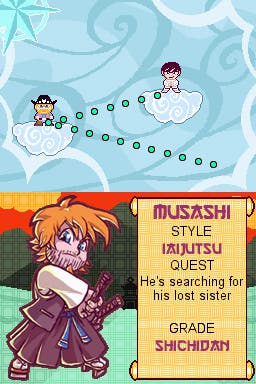Zendoku
Shouldoku points for the name.
Pseudoku? That's what you might be thinking when you first spot Eidos' irreverent replacement of Sudoku's traditional numbers for seemingly arbitrary eastern symbols. But rest assured, this is the same orthodox pen and pencil puzzle game that depressingly saved British newspaper sales in all but name and face.
Of course, the recently ubiquitous Japanese puzzle loved by commuters and evangelised by Carol Vorderman has never had anything much to do with numbers anyway - it's a pure logic puzzle. Played on a 9x9 square grid, the aim of the game to fill every row, column and 3x3 sub-box with one of each number from one to nine. There can be no repeats and only logic (no guesswork) can be used to fill the grid. Manage to slot everything in its right place and the panic will go away for a little bit and maybe you'll sleep at night believing you really are in control of your life.
Of course, as each number simply represents a different type of object, one could use nine elements from the periodic table or nine different positions from the Karma Sutra for the game's symbols and it would still play in exactly the same way. In a sense then, that Zendoku doesn't share Sudoku's staid, black and white numerical presentation is irrelevant - underneath the new icons and kung-fu themed textures, it's basically the same game.

So it's probably worth reviewing Sudoku's paper-based gameplay before we move on to the success or failure of this digital interpretation. Well, it's OK. Three or four years ago, when the first Sudoku puzzles crept onto the back page of The Times with their unknown logic and murky solving techniques they were both enticing and compelling. But now, long after the phenome-wagon has passed, they're mostly a bit dull.
Once the advanced techniques have been uncovered, working through the endless supply of incrementally differently arranged puzzles is mostly a joyless chore. Unlike say Picross, which leaves you at least with a blocky picture at the end for your efforts, a completed Sudoku grid is an ugly mess of meaningless data: flower-arranging for the obsessive-compulsive logic nerd. Still, the learning's the drug and, while you're learning, Sudoku is a commute-easing, mind-itching, enjoyable timewaster. 7/10
So, onto this game's execution of that well-known gameplay which, you'll be pleased to hear, is both interesting and creative. The premise is simple: marry the single-player cerebral challenge of the Sudoku puzzle with the two-player urgent competitiveness of Street Fighter. And, if Super Puzzle Fighter has taught us anything, it's that marrying Street Fighter to any other type of gameplay has the potential to work well.
Indeed, being pretty good at Sudoku puzzles already is almost a prerequisite to Zendoku as you'll be competing against various opponents to try and fill a grid first. As a result, the puzzles are a little on the easy side, but the pressure of having to race an opponent makes this mild dumbing down a sensible move on the part of the developer.
The game structure is basically Street Fighter 2. You've eight characters to choose between (four weapon-wielding fighters and four hand-to-hand) and you must progress through a series of internationally-themed stages, facing off against other larger-than-life opponents. There's a brief cut-scene before and after each fight when hit-and-miss dialogue is traded and, at the end of the competition, you can call yourself Doshu.

Within battle each character has a life bar and every time you complete a row, line, box, set of symbol type or, finally, grid, you fire off an attack move towards your opponent. These attacks take the form of Warioware-style microgames, interrupting your Sudoku-solving, and must be successfully cleared before you or your opponent can get back to the business of cracking the main puzzle.
The attack-based microgames revolve around the DS's various hardware features, requiring you, for example, to blow out candles or block little punches with the stylus. They vary wildly in difficulty (and can be attempted in their very own separate game mode) and, at the top end of the spectrum, can sometimes become deeply irritating as there's no way to pass until you meet their completion criteria. It's possible to block attacks by correctly placing one instance of your lucky symbol (each character is assigned one) on the board - an inelegant but functional gameplay solution to defence.
Another problem with the formula is that the new Sudoku icons, while a perfectly reasonable attempt to spruce up what would otherwise be a functional interface, are simply not as easy to read as numbers at high speeds. Often you'll be checking lines three or four times before you realise which symbol is missing.
Nevertheless, with a whole orthodox Sudoku mode as well as the main head-to-head Zendoku attraction, this is a generous package that injects some freshness and urgency into an otherwise stale puzzle game that's already adequately represented on the DS. Thanks to the game's fundamental competitive structure, in two-player mode it shines and the charming art style, which ably mimics Japanese fighting game aesthetics, lends the package character sorely missing from its DS Sudoku rivals.

